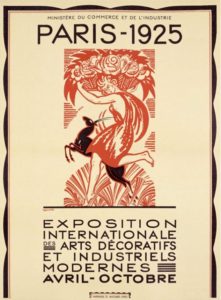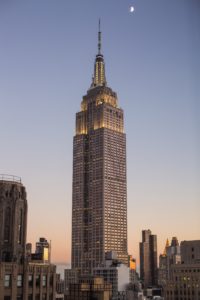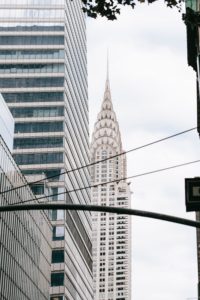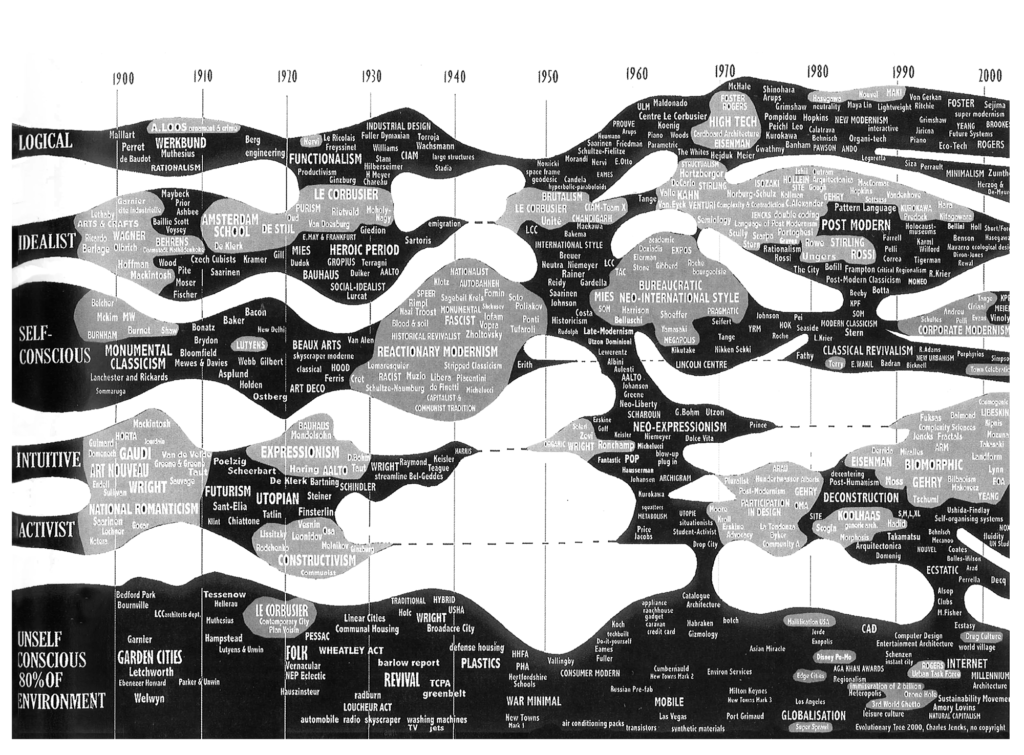Hi everyone, this article is a part of the new series emphasizing the multiple styles in architecture! Last week, we took a look at the popular mid-century modern, but today we will be dissecting Art Deco!
Before we get started, let’s look at the diagram of the timelines below of the 19th and 20th-century architectural styles, ideologies, designers, and more to give you a better footing of our series. As you can tell, there’s a lot, and we will do our best to give you digestible information. It’s important to note, there’s no particular order we are writing, but every article will have this diagram for you to reference!
The Origin
The Art Deco movement in arts and architecture originated in the 1920s and developed into a major style in western Europe and the United States during the 1930s. It’s important to note that there are subsets within Art Deco that I may not fully capture in this article. This architectural style first came to public attention in 1922 when Finnish architect Eliel Saarinen (father of Eero Saarinen) entered a design competition for the Chicago Tribune Headquarters. Although it didn’t win, the style was widely publicized as new and exciting following previous architecture styles post-WW I.
Where did the name come from?
 Meanwhile, its name was derived from the Exposition Internationale des Arts Decoratifs et Industriels Modernes, held in Paris in 1925, where the style was first exhibited. However, the exposition had a whopping over 15,000 artists, architects, and designers displaying their work between the esplanade (open area) of the Les Invalides and the entrances of the Petit Palais and the Grand Palais on both sides of the Seine River over the span of 7 months!
Meanwhile, its name was derived from the Exposition Internationale des Arts Decoratifs et Industriels Modernes, held in Paris in 1925, where the style was first exhibited. However, the exposition had a whopping over 15,000 artists, architects, and designers displaying their work between the esplanade (open area) of the Les Invalides and the entrances of the Petit Palais and the Grand Palais on both sides of the Seine River over the span of 7 months!
Time and Place in History
Art Deco design represented modernism turned into fashion. Its products included individually crafted luxury items and mass-produced wares; in either case, the intention was to create a sleek and anti-traditional elegance that symbolized weather and sophistication. The masses embraced this new look as it symbolized a strong economy and inspired hope for a prosperous future.
19th century for architecture was all about being re-envisioned or explored through innovative modern technology. The entire world sought something “new” following the events of the 19th century. As one of the many architectural movements, Art Deco finds its influences from Art Nouveau, the Bauhaus, and Cubism which we will dissect later.
Where can you find Art-Deco Architecture?
Although not always the case, this style can be typically found at theaters, commercial buildings, offices, government headquarters, apartments, or industrial complexes. Without further ado, here are 5 key elements that will help you recognize this style! I’ll provide a handful of notable Art Deco architecture below too!
- Senate House, London
- Chrysler building, New York
- Empire State Building, New York
- The Carlyle, Miami
- Chicago Board of Trade Building, Chicago
- Fisher Building, Detroit
- LA City Hall, LA
- Mossehaus, Berlin
- Centre for Fine Arts, Brussels
- Rex Theatre, Athens
- Palais de Tokyo, Paris
1. Streamlined, Modern Design
Art deco’s general form was an intentional break with Art Nouveau to embody the ideas of the modern age, looking forward from the past. While the Art Nouveau movement is rooted in intricated, stylized forms from nature, most of Art Deco’s buildings form follow sleek, linear, often rectangular geometric forms, arranged and broken up by curved ornamental elements.
 Since the Art Deco style rejected historical precedents in its use of new construction technology, it was ideal for designing the 20th century’s newly emerging building form, the skyscraper – Empire State Building being a great example.
Since the Art Deco style rejected historical precedents in its use of new construction technology, it was ideal for designing the 20th century’s newly emerging building form, the skyscraper – Empire State Building being a great example.
To reiterate, the sleek design of Art Deco embodies a desire for a flourishing economy and a promising future. While the overall form is streamlined, a building can be adorned with angular, geometric patterns bringing us to our next point!
2. Angular, Geometric Patterns
 Various motifs and ornamental details were adorned on Art Deco buildings! Some common Art Deco motifs include chevrons, pyramids, stylized sunbursts or florals, zig-zags, sweeping curves, Egyptian motif, floral motifs, bird motifs, and other geometric shapes. Windows and doors were decorated with geometric designs too!
Various motifs and ornamental details were adorned on Art Deco buildings! Some common Art Deco motifs include chevrons, pyramids, stylized sunbursts or florals, zig-zags, sweeping curves, Egyptian motif, floral motifs, bird motifs, and other geometric shapes. Windows and doors were decorated with geometric designs too!
On the other hand, architectural purists and critics weren’t as receptive to this style as the masses because they felt it lacked substance.
Do you agree with that mentality? I’m not an architectural purist at all, so I being on the less critical side, appreciate the insight Art Deco offers to the conversation.
3. Symmetrical and Repeating Patterns Exterior and Interior
A designer or architect would include similar Art Deco elements on both the exterior and interior so that each building carried out a consistent theme. Many facades were created using vertical lines that were angular and pointed upward and outward. These triangular shapes were capped off with a series of steps that eventually come to a point, like the Chrysler Tower.
Windows in Art Deco designs usually appear as punctured openings, either square or round. To maintain a streamlined appearance for the building, they were often arranged in continuous horizontal bands of glass. Wall openings are sometimes filled with decorative glass or glass blocks, creating a contrast of solid and void forms while admitting daylight.
4. Bold Colors
Art Deco projects produced some of the most dynamic collaborations between architects, painters, sculptors, and designers – sometimes resulting in Art Deco environments like Old Miami Beach, Florida. Because of this iconic streetscape, some might say that bright, opulent colors, like green, yellow, turquoise, or ruby, are synonymous with Art Deco. However, buildings could incorporate stark colors like black and white or gold and silver to create contrasts, as they do in New York City.
Art deco is pretty much in fashion, depending on where you are located. For example, it’s hard to imagine nightlife at Ocean Drive in Miami without their color lights and playful facades decorating the face of the beach.
5. Liberal Use of Sleek-Looking Materials
As the name implies, Art Deco is not concerned about concealing elaborate decorations. Although a substrate of Art Deco can use less sleek-looking materials, most Art Deco buildings utilized decorative glass, chrome, steel, aluminum, and marble. As long as materials and composition are utilized to express abundance and excitement, any material can embody the spirits of this style. Although it seems a little over the top to most of us who are used to contemporary, modernist architecture, this type of extravagance made a lot of sense back then! If you want to expand your chronicle empathy and simply curious about how this era might have looked like, the novel The Great Gatsby by Scot Fitzgerald can give you a glimpse into the life and the zeitgeist of this time – a booming economy, exuberant parties, and all the raging night lives. It’s no wonder the ’20s are now known as ‘the roaring 20s’.
Although most remarkable Art Deco buildings are located in New York City, Napier, New Zealand, is actually the self-proclaimed Art Deco Capital of the world. New Zealand is definitely on my bucket list, but if you get there before I do, let us know about your experience in the comments below! Also, if you’d like a little more exploration on Art Deco, A 1984 book, Washington Deco by Hans Wirz and Richard Striner, catalogs over 400 Art Deco buildings in the Washington, D.C. area alone!
Well, that’s all we have for you today, and if you’ve made it this far, you deserve a cookie🥠. I hope you found this article interesting and took something from it! Sharing is caring! We hope to provide you with valuable insights and share them with someone who might find this useful. Make sure to follow our Youtube and Instagram for more content!



Pingback: Discover Art Nouveau Architecture with these 5 Characteristics! – Archi Hacks